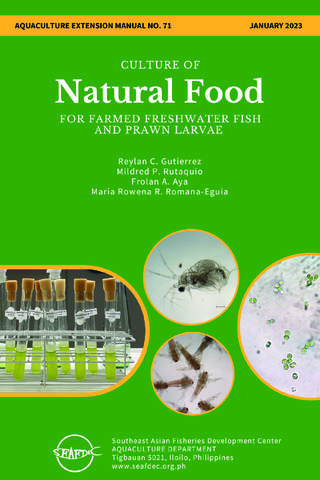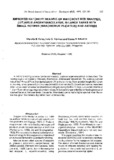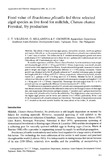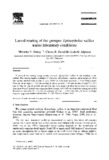Culture of natural food for farmed freshwater fish and prawn larvae
Share
Abstract
This manual describes the various methods for culturing microalgae and other natural food organisms fed to freshwater fish/prawn larvae that are produced and reared in hatcheries. Hence, it will encourage/ promote the use of natural food organisms be these live and/or processed (concentrated algal pastes), as a means of optimizing larval fish/prawn production.
The manual was written purposely for local freshwater fish/prawn hatchery owners/operators and their technicians. The authors prepared the manual for hatchery operators to have a better understanding of how and why there is a need to culture natural food organisms as part of the standard larval rearing protocol and to increase/boost fish and/or prawn seedstock production.
Other versions
FilipinoSuggested Citation
Gutierrez, R. C., Rutaquio, M. P., Aya, F., & Romana-Eguia, M. R. R. (2023). Culture of natural food for farmed freshwater fish and prawn larvae. Aquaculture Department, Southeast Asian Fisheries Development Center.
Subject
larvae  ; feeding
; feeding  ; phytoplankton
; phytoplankton  ; Algae
; Algae  ; zooplankton
; zooplankton  ; live feeds
; live feeds  ; freshwater fishes
; freshwater fishes  ; growth
; growth  ; survival
; survival  ; culture media
; culture media  ; algal culture
; algal culture  ; sterilization
; sterilization  ; isolation techniques
; isolation techniques  ; manuals
; manuals  ; carp
; carp  ; Rotifera
; Rotifera  ; Chlorophyceae
; Chlorophyceae  ; microalgae
; microalgae  ; Philippines
; Philippines 
 ; feeding
; feeding  ; phytoplankton
; phytoplankton  ; Algae
; Algae  ; zooplankton
; zooplankton  ; live feeds
; live feeds  ; freshwater fishes
; freshwater fishes  ; growth
; growth  ; survival
; survival  ; culture media
; culture media  ; algal culture
; algal culture  ; sterilization
; sterilization  ; isolation techniques
; isolation techniques  ; manuals
; manuals  ; carp
; carp  ; Rotifera
; Rotifera  ; Chlorophyceae
; Chlorophyceae  ; microalgae
; microalgae  ; Philippines
; Philippines 
Taxonomic term
Chlorella  ; Brachionus
; Brachionus  ; Moina
; Moina  ; Artemia
; Artemia  ; Macrobrachium rosenbergii
; Macrobrachium rosenbergii  ; Oreochromis niloticus
; Oreochromis niloticus  ; Aristichthys nobilis
; Aristichthys nobilis  ; Hypophthalmichthys nobilis
; Hypophthalmichthys nobilis  ; Clarias macrocephalus
; Clarias macrocephalus  ; Chanos chanos
; Chanos chanos  ; Leiopotherapon plumbeus
; Leiopotherapon plumbeus  ; Brachionus rotundiformis
; Brachionus rotundiformis  ; Chlorella sorokiniana
; Chlorella sorokiniana  ; Chlorella vulgaris
; Chlorella vulgaris  ; Nanochlorum
; Nanochlorum  ; Arthrospira platensis
; Arthrospira platensis  ; Brachionus plicatilis
; Brachionus plicatilis  ; Nannochloropsis
; Nannochloropsis  ; Tubifex tubifex
; Tubifex tubifex 
 ; Brachionus
; Brachionus  ; Moina
; Moina  ; Artemia
; Artemia  ; Macrobrachium rosenbergii
; Macrobrachium rosenbergii  ; Oreochromis niloticus
; Oreochromis niloticus  ; Aristichthys nobilis
; Aristichthys nobilis  ; Hypophthalmichthys nobilis
; Hypophthalmichthys nobilis  ; Clarias macrocephalus
; Clarias macrocephalus  ; Chanos chanos
; Chanos chanos  ; Leiopotherapon plumbeus
; Leiopotherapon plumbeus  ; Brachionus rotundiformis
; Brachionus rotundiformis  ; Chlorella sorokiniana
; Chlorella sorokiniana  ; Chlorella vulgaris
; Chlorella vulgaris  ; Nanochlorum
; Nanochlorum  ; Arthrospira platensis
; Arthrospira platensis  ; Brachionus plicatilis
; Brachionus plicatilis  ; Nannochloropsis
; Nannochloropsis  ; Tubifex tubifex
; Tubifex tubifex 
Collections
Except where otherwise noted, this item's license is described as Attribution-NonCommercial-ShareAlike 3.0 IGO
Related items
Showing items related by title, author, creator and subject.
-
Improved hatchery rearing of mangrove red snapper, Lutjanus argentimaculatus, in large tanks with small rotifer (Brachionus plicatilis) and Artemia
Duray, Marietta N.; Alpasan, Lota G.; Estudillo, Chona B. (Society of Israeli Aquaculture and Marine Biotechnology, 1996)A hatchery rearing scheme for the red snapper, Lutjanus argentimaculatus, is described. The feeding regime consisted of Chlorella, Brachionus, Artemia and minced fish. The average survival rate at day 24 was 27% in 3-ton ... -
Food value of Brachionus plicatilis fed three selected algal species as live food for milkfish, Chanos chanos Forsskal, fry production
Villegas, Cesar T.; Millamena, Oseni; Escritor, F. (Blackwell Publishing, 1990)The effects of three selected algal species, Tetraselmis tetrahele, Isochrysis galbana and marine Chlorella sp. on the population growth of Brachionus plicatilis was evaluated after 3, 5 and 7 days of culture. The rotifers ... -
Larval rearing of the grouper Epinephelus suillus under laboratory conditions
Duray, Marietta N.; Estudillo, Chona B.; Alpasan, Lota G. (Elsevier, 1997)A protocol for rearing orange-spotted rockcod, Epinephelus suillus in the hatchery is described. The feeding regime consisted of Chlorella, Brachionus, Artemia and minced fish. With this regime, survival rates at Day 24 ...





